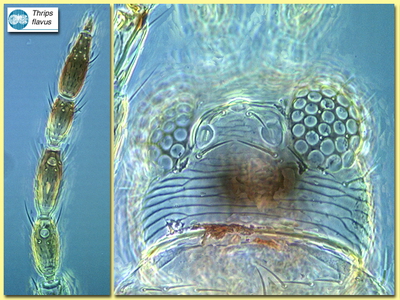Figures
Fig. 1 Antenna and head (dorsal)
Fig. 2 Pronotum
Fig. 3 Meso- and metanotum
Fig. 4 Meso- and metanotum
Fig. 5 Fore and hind wing
Fig. 6 Tergite VII
Species
Thrips flavus SchrankBiology
A very widespread and highly polyphagous flower-living species that is reported as causing damage to the leaves of a wide range of plant species, although misidentifications limit the reliability of published records.
Distribution
Throughout Europe and Asia, but not in North America.
Recognition
Medium sized yellow thrips, with forewing pale and distal antennal segments light brown. Antennae 7-segmented, III & IV with sense cone small and forked. Head with no setae in front of fore ocellus, one pair just behind fore ocellus within the ocellar triangle. Pronotum with 2 pairs of posteroangular setae. Metanotum with curving transverse lines of sculpture at anterior, but elongate reticulation on posterior half but lines not converging posteriorly; median setae not at anterior margin. Forewing first vein with 3 setae on distal half. Tergite II with 4 lateral marginal setae; V-VIII with ctenidia laterally, on VIII posteromesad of spiracle; posteromarginal comb on tergite VIII long and irregular. Sternites and pleurotergites with no discal setae.
Related species
This yellow species is very similar in structure to the tropical species Thrips palmi. Moreover, Nakahara (1994) refers to two further North American species that are also similar in structure and colour.







